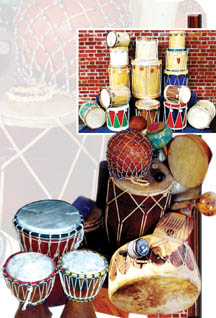
The beat goes on...
In our last Heritage Splendour page, we introduced you to traditional
Sri Lankan drums and even described four of those varieties. Today, we
are going to take you further into the world of drums.
Do you know what the smallest local drum is? It is the Udekkiya. This
is played with one hand and the sound is controlled by pressure applied
on the strings. The drum is shaped like an hourglass. It is made of
Ehela, Milla or Suriya wood and is nicely painted with lacquer. The
side-openings are covered with iguana, monkey or goat skin.

The next drum variety, Dakkiya is very similar to the Udekkiya, but
is bigger. This is used mainly in rituals. The drum is hung on the
shoulder of the player and the sound is controlled by applying pressure
on the strings. Most drums are generally carved out of wood and the part
that is used to play is covered by animal skin.
You'll be amazed to hear that there is a drum made out of clay as
well. The only one of that kind, it's known as Bummadiya. It has a
single opening covered with the skin of goat, monkey or iguana. The drum
is hung on the shoulder of the player and is beaten with both hands.
During harvesting, people could be seen playing this drum; it's
accompanied by singing. The drum is in the shape of a pot, but please
don't try to make a Bummadiya with your mother's clay pots!
These are examples which show how rich our heritage is. We are sure
some of you might be hearing the names of some of these drums for the
very first time.
Now, here comes the most popular, most well-known and the most widely
played kind of drums - the Hand Rabana and the Bench Rabana. The Hand
Rabana is mostly used as an accompaniment to Virindu songs. It is about
one foot in diameter and is turned out of Kos or Milla wood.
The skin used is that of a goat. Some performers keep revolving the
rabana on the tip of their fingers while others play it while they are
singing. This is played with only one hand and is used in Raban Netumas
as well.
The Raban Netuma is a traditional folk dance which uses Raban. The
Hand Rabana is both played and waved around in a variety of ways by male
or female dancers. We have already spoken about the smallest drum. Now
comes the giant in the family of drums.
This is very popular among everyone. Can you guess what it is? Of
course, it is the Bench Rabana. The special feature of this drum is that
it can be played by two or more people at the same time. They use both
hands. This drum is commonly used at New Year festivals and many special
rhythms are played on them. It is mostly played by women. During the New
Year, Raban games are also organised where the team that plays best are
rewarded.
That is enough about drums. Shall we now take a look at some of their
important uses?
When we explained drums, we told you that they are widely used to
provide music for dancers. Do you know that there are three different
dancing traditions in Sri Lanka and each one has its own drum?
The Kandyan dancers use the Kandyan drum or Geta Bera; the low
country dancers use the Yak Bera; and the Sabaragamuwa dancers use the
Dawula. The latter is very important in Buddhist religious ceremonies
too. We explained in our previous article that the Thammattama is also
known as the twin drum. It is believed that it should not be played
singly. Drums play a major role in our cultural events.
The Raban Netuma, which we explained earlier, and the Magul Bera
ceremonies are major events where drums are used. The Magul Bera
ceremony is one of the most important cultural events in Sri Lanka. Most
of our traditional ceremonies start with the playing of Magul Bera. It
is an ancient Sinhalese custom to present ritual music when seeking the
blessings of the guardian deities of the land.
The blowing of conch shells is a traditional sight at the
commencement of any function and drums too play an integral part in
these rituals.
Next time you see a drum, try to identify it. If it was not mentioned
by us here, share the details with us. We will tell you more about drums
in the future. What do you say, drumming is interesting and amazing,
isn't it?
Janani Amarasekara |


